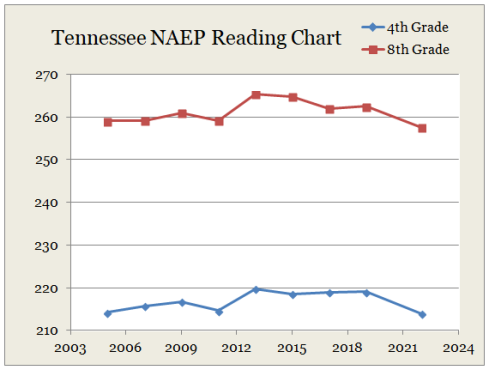By Thomas Ultican 5/1/2024
Neoliberals joined with libertarians to “reform” public education. Their tools were big money and propaganda distributed by media outlets like The 74, support by The Walton family (EIN 13-3441466) and Bill Gates (EIN 56-2618866). This year, regular columnist for The 74, Chad Aldeman, is trying to claim that lifting No Child Left Behind (NCLB) school accountability sanctions is responsible for the public school testing “data decline”.
Aldeman came east from the University of Iowa, with his BA in Public Policy, to gain a Masters in Public Policy from William and Mary University. His first job in 2008 was with the neoliberal Education Sector which states, “Since our founding in 2005, Education Sector has established our expertise in key issue areas—including educational choice, human capital, K–12 accountability, and higher education—and gained credibility as an independent leader in the field.” (emphases added)
After three years, Aldeman joined Arne Duncan’s Department of Education as a Confidential Assistant and left the Department in 2012 for neoliberal oriented Bell Weather Education Partners as a Principal, working there until 2020.
Diane Ravitch said of Bell Weather in 2016:
“Bellwether, co-founded by Andrew Rotherham, is a leading force in the corporate reform movement. Rotherham has been a columnist for TIME. Currently he is on the board of Campbell Brown’s THE 74.
“Among its clients: TN Achievement School District, National Alliance for Public Charter Schools, NewSchools Venture Fund, Rhode Island Department of Education, Stranahan Foundation, Walton Family Foundation, Stand for Children, CEE-Trust, Goodwill Education Initiatives, Harmony Public Schools (Gulen charter schools), TNTP, Rocketship Education (charter chain), KIPP, IDEA charter schools, The Mind Trust, Chiefs for Change, TeachPlus, and the Black Alliance for Education Options.”
I used this quote, because Bellweather’s list of clients has gotten much larger, extra disgusting but not more illuminating.
Bottom-line: Aldeman is steeped in anti-public school dogma.
Going on the Attack
Aldeman’s latest piece for The 74 is called “Gaps Widening Between Indiana’s Highest- and Lowest-Performing Students,” claiming that since approximately 2013 education outcomes as measured by test scores were bad. He stated gaps between highest- and lowest-performing students were widening while overall scores declined and this was not just an Indiana problem but a national one.
The following is one of his graphs, Indiana 4th grade reading outcomes.
Chad Aldeman Graph from The 74
In the article he stated from 2003 to 2015, the average gains went up by 7 points and from 2015 to 2022, the average losses were 10 points. What he did not mention was where the test data came from and what its maximum scale was. If this happened to be a testing performance based on a 1,000 point scale, a 10 point change is fairly meaningless even if you believe in standards-based testing.
To check if there was any reality to Aldeman’s graph, I interrogated data from the National Assessment of Education Progress (NAEP). Using free lunch as a proxy for low-performing students, both national data and Indiana data for 4th grade reading was graphed. NAEP, known as the nation’s report card, has given the same type of reading exams since 1992. Indiana changed its ELA testing regime in 2018 which makes evaluating data from 2010 when the last testing method was adopted, difficult to impossible. It lacks continuity.
Reading data is scored on a 500 point scale. Scores above 250 and below 190 are meaningless for the 4th grade reading test. Testing score gaps between students eligible for free lunch and those not, in the US, wavered between 26 and 28 points. In Indiana, it varied from 20 to 23 points with one outlier in 2019 at 27 points. The gap between top and bottom has been unchanged within a 3 or 4 point range. Since 1992, 4th grade reading data average for the nation has wiggled up and down within a ten point range. The first test data in 1992 came in at a 217 points average and was also 217 points in 2022.
From 1970 to 1992, America’s schools showed slow but steady improvement in education-testing outcomes but since the era of standards, testing and accountability, improvement basically stopped. Education, run by billionaires and politicians instead of educators, failed to improve testing outcomes.
What Happened?
Alderman stated in his latest article that it is not just an Indiana problem but that “49 of 50 states, the District of Columbia and 17 out of 20 of the large cities that participated in NAEP … saw a widening of their achievement gap over the last decade.” He did not share which tests showed widened achievement gaps nor which cohorts were compared. NAEP reports on reading scores for 4th and 8th grade do not show a significant change in scoring gaps between Black and White students and comparisons in other ethnic groups also were steady.
After asking what has caused this (non-existent) achievement gap increase, Alderman posited several possible reasons: Common Core state standards (CCSS), per-pupil spending, technology and social media. He said the timing for CCSS fit but did not explain why states where CCSS was never adopted had the same problem. For per-pupil spending, he claimed that more money was getting to classrooms, which defies education-spending reports, making his claim a little shady. For technology and social media, he said other countries with similar problems, did not see testing declines … a declaration made with no evidence cited.
He finally made his real point, “I argue that the weakening of school accountability pressures after the No Child Left Behind Act was passed is responsible for a large portion of the drop.” Those of us, who were in classrooms and witnessed the test-and-punish philosophy damage to public education, disagree. How many great public schools were labeled “failures and closed” because they existed in low income zip codes?
If this decline were real, wouldn’t the privatization of public education be the most likely culprit? Charter schools came first followed by vouchers and more charter schools. Data clearly shows that vouchers harm student-testing performance. Furthermore both charter schools and voucher schools leech money from public education budgets.
Conclusions
The 74 was founded in 2015 by former CNN news anchor, Campbell Brown, along with Michael Bloomberg’s education advisor, Romy Drucker. Its original funding came from the Dick and Betsy DeVos Family Foundation, Walton Family Foundation, Doris and Donald Fisher Fund and Bloomberg Philanthropies. Since then, it has been the vehicle for spreading the billionaire message of privatization and undermining public schools.
Some billionaires see the non-sectarian nature of public education as a threat to their dreams of a Christian theocracy. Others are libertarians that oppose free universal public education, believing everyone should pay one’s own way and not steal people’s private properties using taxation. The Neoliberals are convinced that education should be run like a business and react to market forces.
Responding to the mission of The 74, Chad Aldeman’s series of articles, like those of many of his colleagues, are pure propaganda, shaping data to support his neoliberal ideology instead of honestly reporting facts. Unfortunately this kind of fake “journalism” is flooding email boxes and web pages throughout America every day.


























